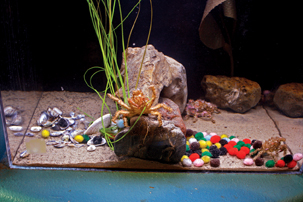 A marine gem in Avila Beach
A marine gem in Avila Beach
The warm south-facing coastline isn’t the only attraction in Avila Beach. For people who love the ocean and all the critters in it, there is the Avila Beach Sea Life Center. Just yards from the sand is the two-story sandstone-colored building that is home to the center, where marine aquariums and exhibits about life in the ocean and the estuary are housed.
The mission of this non-profit is to educate children in a hands-on manner to encourage a long-lasting interest in science. Visitors have up-close encounters with marine life and, ultimately, develop a better understanding of Avila’s marine environment.
The staff at the Sea Life Center offers tours of the facility, which are led by a volunteer docent – though visitors are also welcome to walk around and explore the center on their own. There is much to see, as the Sea Life Center houses both museum and aquarium aspects. Visitors will see a large tile mural created by the Chumash tribe that depicts their history of living next to the sea. Below the mural is a wooden canoe specially built for the center.
Across from the Chumash exhibit is another mural, a painted scene depicting the variety of sea life that can be found in Avila Beach. The mural shows how different currents affect local marine life. Next to the mural is the nursery for brine shrimp. “This is where we grow our brine shrimp,” Priscilla Kiessig, Executive Director of the center, said, “and we use them to feed the other sea creatures that live in the aquariums.” The microscopic shrimp, which make up the basis of the food chain in the ocean, are started in a special beaker and grown to a certain size. Then they are transferred to another container where they grow further until reaching full size.
Next to the shrimp nursery is a microscope and two computer monitors. This is the Discovery Lab. “During our special programs that school children take part in, the microscope is used to look at samples of life that reside in the ocean water,” explained Kiessig.
The Center is home to anemones, abalone, sea urchins, and crabs in a variety of aquariums. One tank houses the decorator crabs and small fuzzy colorful balls are strewn on the bottom. “This animal likes to adorn himself with a variety of items in the sea for camouflage,” Kiessig explained. “We gave him those balls to emphasize to visitors how they do this.”
In the kelp aquarium, there are rockfish and the colorful Garibaldi, the state fish of California. The next tanks have what some people find most interesting, sharks and rays. One tank holds egg sacks of leopard and horn sharks. Visitors can touch the sharks and rays – rays are slimy to the touch, while sharkskin is abrasive and raspy like sandpaper.
A large round aquarium has leopard sharks that have outgrown the smaller tanks. These fish can grow to about six feet in length. Recently the Center was gifted a 3,000 gallon aquarium. Kiessig hopes that soon they will be able to expand the facility to utilize this tank. “When fish such as the sharks get too large for us, we have to send them to larger facilities,” she said.
Another fascinating exhibit is the moon jelly aquariums. The Center’s aquarist, Amanda Howarth grows them and you can see each successive tank showing the progression, starting them as microscopic jellies that cling to a special fixture in the water, then as very tiny jellies swimming, and then larger and larger in the last two aquariums. It is exhibits like this that make the Sea Life Center a frontrunner in marine life education.
Besides the aquarium, other programs the Center offers are birthday parties with a choice of different activities. Parties like these can accommodate up to 10 guests. Summertime brings Summer Camp for the children.
The Center also offers a Floating Laboratory class, where kids board a boat and do scientific exploration, just like marine biologists do. They pull the bottom trawl on the boat and bring up sea life. Then they sort out the catch, learning to identify each species. Plankton samples are taken and the chemistry of ocean water is studied. While out on the boat the class is able to observe marine mammals such as sea lions and harbor seals and a variety of sea birds. Back in the lab they dissect squid, identify its parts and learn how this animal lives in the ocean.
“We’ll be starting our Second Science Sundays, to take place once a month where adults will get to do these same programs that the kids are doing,” Kiessig said. “During summer months, adults will get to go out on the boat too.” There will also be community programs with lectures that will emphasize what is being done to help the oceans. Rotating exhibits will showcase certain things such as one called Sea Surprise and one about bioluminescent creatures that live deep in the ocean.
It is possible to become a member of the Avila Beach Sea Life Center for $25 for an individual and $65 for a family. Guests can adopt a Sea Life Center animal with a choice of a bat ray, swell or leopard shark, octopus, decorator crab, cabezon, bat star, and Kellet’s whelk. Adoption fee gives guests an adoption certificate, a poster or picture of the adopted animal and a fact sheet and monthly update on the adoptee. With two free passes to the Center, adoptive “parents” will also get to feed his or her animal.
Come to Avila Beach and stop in to visit the marine creatures. On Saturdays, a feeding tour is offered at noon, and general admission tours run daily at 2:00. Tours last 40 minutes and are on a walk in basis. Visitors can also make tour reservations for groups of up to 20 people. Call 805-595-7280 for information or go to www.sealifecenter.org.
— By Ruth Ann Angus










